ECO mode FIAT STILO 2006 1.G Owners Manual
[x] Cancel search | Manufacturer: FIAT, Model Year: 2006, Model line: STILO, Model: FIAT STILO 2006 1.GPages: 274, PDF Size: 4.76 MB
Page 81 of 274
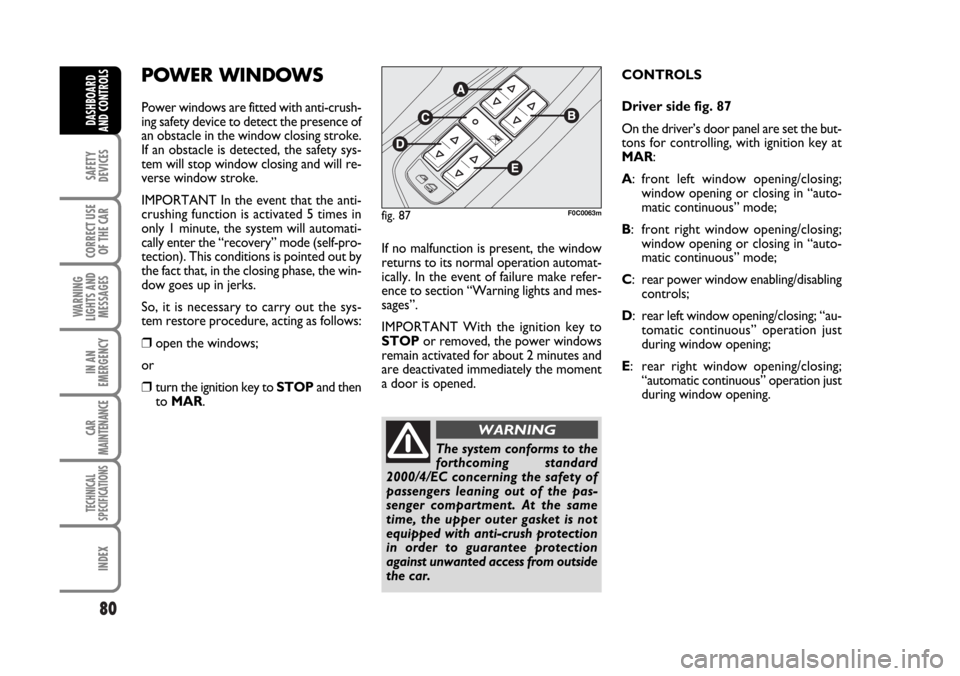
80
SAFETY
DEVICES
CORRECT USE
OF THE CAR
WARNING
LIGHTS AND
MESSAGES
IN AN
EMERGENCY
CAR
MAINTENANCE
TECHNICAL
SPECIFICATIONS
INDEX
DASHBOARD
AND CONTROLS
POWER WINDOWS
Power windows are fitted with anti-crush-
ing safety device to detect the presence of
an obstacle in the window closing stroke.
If an obstacle is detected, the safety sys-
tem will stop window closing and will re-
verse window stroke.
IMPORTANT In the event that the anti-
crushing function is activated 5 times in
only 1 minute, the system will automati-
cally enter the “recovery” mode (self-pro-
tection). This conditions is pointed out by
the fact that, in the closing phase, the win-
dow goes up in jerks.
So, it is necessary to carry out the sys-
tem restore procedure, acting as follows:
❒open the windows;
or
❒turn the ignition key to STOPand then
to MAR.If no malfunction is present, the window
returns to its normal operation automat-
ically. In the event of failure make refer-
ence to section “Warning lights and mes-
sages”.
IMPORTANT With the ignition key to
STOPor removed, the power windows
remain activated for about 2 minutes and
are deactivated immediately the moment
a door is opened.CONTROLS
Driver side fig. 87
On the driver’s door panel are set the but-
tons for controlling, with ignition key at
MAR:
A: front left window opening/closing;
window opening or closing in “auto-
matic continuous” mode;
B: front right window opening/closing;
window opening or closing in “auto-
matic continuous” mode;
C: rear power window enabling/disabling
controls;
D: rear left window opening/closing; “au-
tomatic continuous” operation just
during window opening;
E: rear right window opening/closing;
“automatic continuous” operation just
during window opening.
fig. 87F0C0063m
The system conforms to the
forthcoming standard
2000/4/EC concerning the safety of
passengers leaning out of the pas-
senger compartment. At the same
time, the upper outer gasket is not
equipped with anti-crush protection
in order to guarantee protection
against unwanted access from outside
the car.
WARNING
Page 142 of 274
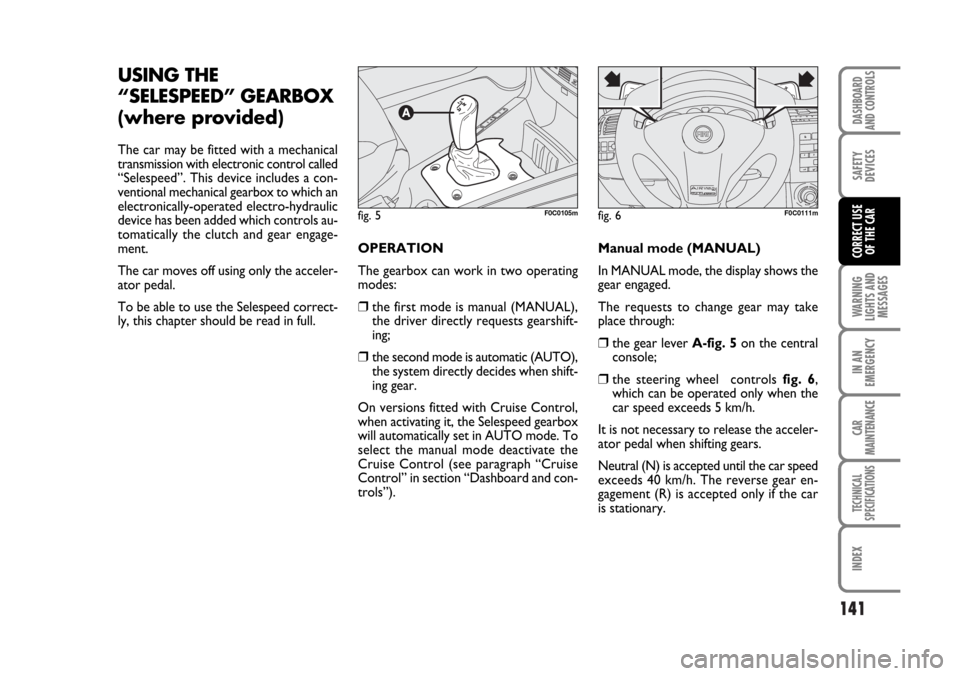
141
WARNING
LIGHTS AND
MESSAGES
IN AN
EMERGENCY
CAR
MAINTENANCE
TECHNICAL
SPECIFICATIONS
INDEX
DASHBOARD
AND CONTROLS
SAFETY
DEVICES
CORRECT USE
OF THE CAR
USING THE
“SELESPEED” GEARBOX
(where provided)
The car may be fitted with a mechanical
transmission with electronic control called
“Selespeed”. This device includes a con-
ventional mechanical gearbox to which an
electronically-operated electro-hydraulic
device has been added which controls au-
tomatically the clutch and gear engage-
ment.
The car moves off using only the acceler-
ator pedal.
To be able to use the Selespeed correct-
ly, this chapter should be read in full. OPERATION
The gearbox can work in two operating
modes:
❒the first mode is manual (MANUAL),
the driver directly requests gearshift-
ing;
❒the second mode is automatic (AUTO),
the system directly decides when shift-
ing gear.
On versions fitted with Cruise Control,
when activating it, the Selespeed gearbox
will automatically set in AUTO mode. To
select the manual mode deactivate the
Cruise Control (see paragraph “Cruise
Control” in section “Dashboard and con-
trols”).Manual mode (MANUAL)
In MANUAL mode, the display shows the
gear engaged.
The requests to change gear may take
place through:❒the gear lever A-fig. 5on the central
console;
❒the steering wheel controls fig. 6,
which can be operated only when the
car speed exceeds 5 km/h.
It is not necessary to release the acceler-
ator pedal when shifting gears.
Neutral (N) is accepted until the car speed
exceeds 40 km/h. The reverse gear en-
gagement (R) is accepted only if the car
is stationary.
fig. 5F0C0105mfig. 6F0C0111m
Page 143 of 274
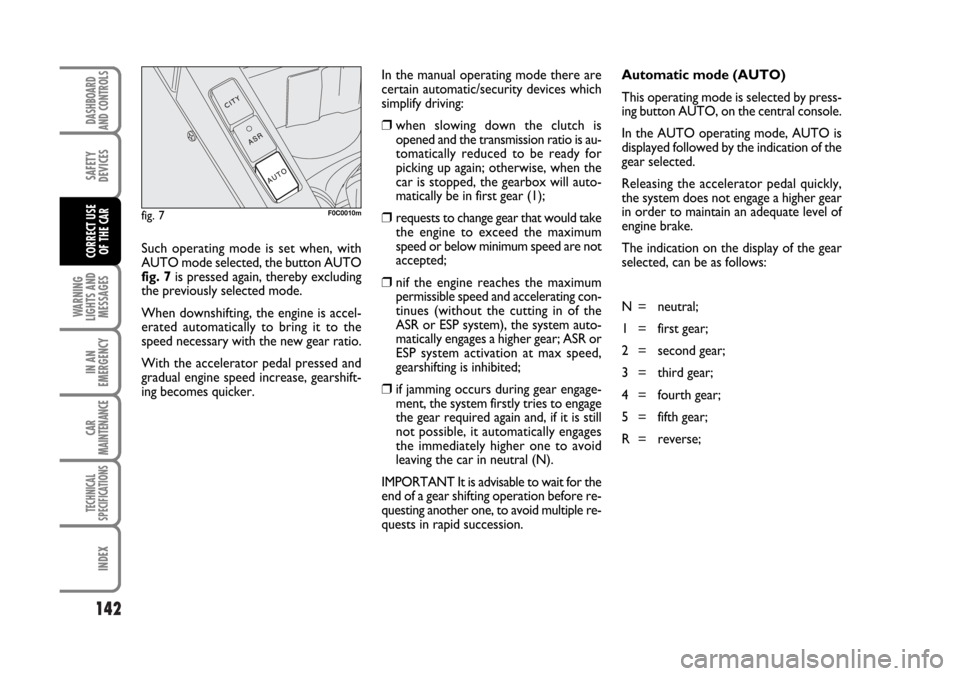
142
WARNING
LIGHTS AND
MESSAGES
IN AN
EMERGENCY
CAR
MAINTENANCE
TECHNICAL
SPECIFICATIONS
INDEX
DASHBOARD
AND CONTROLS
SAFETY
DEVICES
CORRECT USE
OF THE CARSuch operating mode is set when, with
AUTO mode selected, the button AUTO
fig. 7is pressed again, thereby excluding
the previously selected mode.
When downshifting, the engine is accel-
erated automatically to bring it to the
speed necessary with the new gear ratio.
With the accelerator pedal pressed and
gradual engine speed increase, gearshift-
ing becomes quicker.In the manual operating mode there are
certain automatic/security devices which
simplify driving:
❒when slowing down the clutch is
opened and the transmission ratio is au-
tomatically reduced to be ready for
picking up again; otherwise, when the
car is stopped, the gearbox will auto-
matically be in first gear (1);
❒requests to change gear that would take
the engine to exceed the maximum
speed or below minimum speed are not
accepted;
❒nif the engine reaches the maximum
permissible speed and accelerating con-
tinues (without the cutting in of the
ASR or ESP system), the system auto-
matically engages a higher gear; ASR or
ESP system activation at max speed,
gearshifting is inhibited;
❒if jamming occurs during gear engage-
ment, the system firstly tries to engage
the gear required again and, if it is still
not possible, it automatically engages
the immediately higher one to avoid
leaving the car in neutral (N).
IMPORTANT It is advisable to wait for the
end of a gear shifting operation before re-
questing another one, to avoid multiple re-
quests in rapid succession.Automatic mode (AUTO)
This operating mode is selected by press-
ing button AUTO, on the central console.
In the AUTO operating mode, AUTO is
displayed followed by the indication of the
gear selected.
Releasing the accelerator pedal quickly,
the system does not engage a higher gear
in order to maintain an adequate level of
engine brake.
The indication on the display of the gear
selected, can be as follows:
N = neutral;
1 = first gear;
2 = second gear;
3 = third gear;
4 = fourth gear;
5 = fifth gear;
R = reverse;
fig. 7F0C0010m
Page 146 of 274
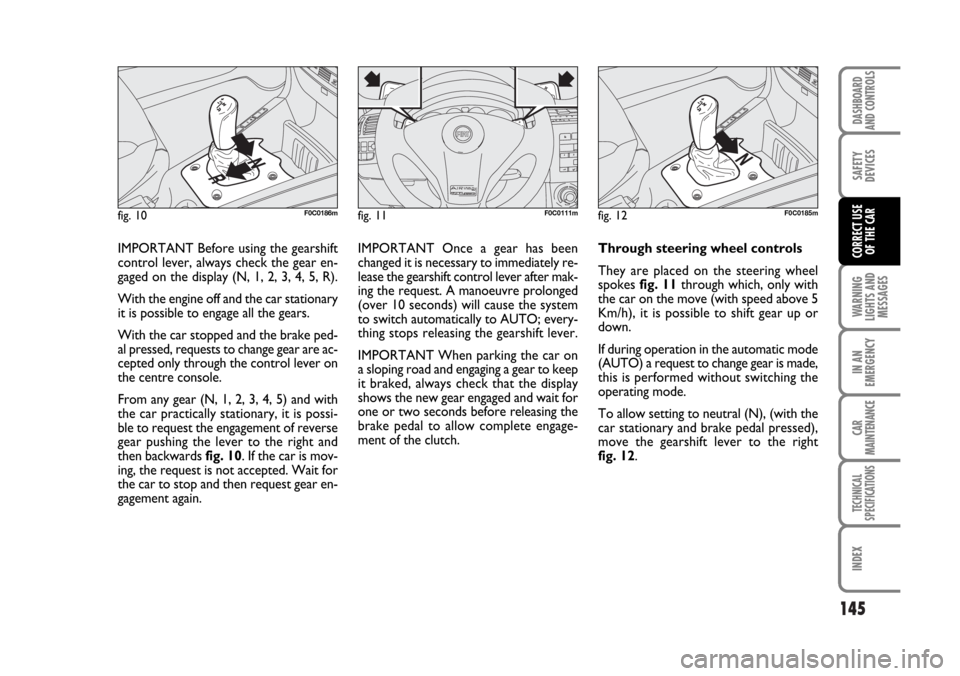
145
WARNING
LIGHTS AND
MESSAGES
IN AN
EMERGENCY
CAR
MAINTENANCE
TECHNICAL
SPECIFICATIONS
INDEX
DASHBOARD
AND CONTROLS
SAFETY
DEVICES
CORRECT USE
OF THE CARIMPORTANT Before using the gearshift
control lever, always check the gear en-
gaged on the display (N, 1, 2, 3, 4, 5, R).
With the engine off and the car stationary
it is possible to engage all the gears.
With the car stopped and the brake ped-
al pressed, requests to change gear are ac-
cepted only through the control lever on
the centre console.
From any gear (N, 1, 2, 3, 4, 5) and with
the car practically stationary, it is possi-
ble to request the engagement of reverse
gear pushing the lever to the right and
then backwards fig. 10. If the car is mov-
ing, the request is not accepted. Wait for
the car to stop and then request gear en-
gagement again.IMPORTANT Once a gear has been
changed it is necessary to immediately re-
lease the gearshift control lever after mak-
ing the request. A manoeuvre prolonged
(over 10 seconds) will cause the system
to switch automatically to AUTO; every-
thing stops releasing the gearshift lever.
IMPORTANT When parking the car on
a sloping road and engaging a gear to keep
it braked, always check that the display
shows the new gear engaged and wait for
one or two seconds before releasing the
brake pedal to allow complete engage-
ment of the clutch.Through steering wheel controls
They are placed on the steering wheel
spokes fig. 11through which, only with
the car on the move (with speed above 5
Km/h), it is possible to shift gear up or
down.
If during operation in the automatic mode
(AUTO) a request to change gear is made,
this is performed without switching the
operating mode.
To allow setting to neutral (N), (with the
car stationary and brake pedal pressed),
move the gearshift lever to the right
fig. 12.
fig. 10F0C0186mfig. 11F0C0111mfig. 12F0C0185m
Page 149 of 274

148
WARNING
LIGHTS AND
MESSAGES
IN AN
EMERGENCY
CAR
MAINTENANCE
TECHNICAL
SPECIFICATIONS
INDEX
DASHBOARD
AND CONTROLS
SAFETY
DEVICES
CORRECT USE
OF THE CAR
STOPPING THE CAR
To stop the car, simply release the accel-
erator pedal and, if necessary press the
brake pedal.
Regardless of the gear engaged and the op-
erating mode activated (MANUAL or AU-
TO) the system automatically disengages
the clutch and shifts to a lower gear.
Stopping the car the system automatical-
ly engages the first gear (1).PARKING THE CAR
To park the car safely it is absolutely nec-
essary to engage first gear (1) or reverse
(R) and also the handbrake if the car is on
a slope.
When turning off the engine with the car
on an uphill slope and a gear engaged, it
is absolutely necessary to wait for the dis-
play showing the gear engaged to go off
before releasing the brake pedal.
If the gearbox is in neutral (N) and want-
ing to engage a parking gear, the system
should be activated and with the foot on
the brake pedal it is necessary to engage
first gear (1) or reverse (R).
TOWING THE CAR
See the instructions contained in para-
graph “Towing the car” in section “In an
emergency”. BUZZER WARNINGS
The buzzer is activated when:
❒reverse gear is engaged (R);
❒clutch overheating occurs when mov-
ing off (in this case it is necessary to
“force” start-up without hesitation or,
if the car is on a slope, release the ac-
celerator and use the brake pedal to
stop the car);
❒an attempt is made to start the engine
with a gear engaged and the brake ped-
al is not pressed completely;
Still for safety reasons, when the car is sta-
tionary, with engine started gear engaged,
the system activates the buzzer and au-
tomatically shifts to neutral (N) when:
❒no action is made on the accelerator
and/or brake pedal for at least 3 min-
utes;
❒the brake is pressed for over 10 min-
utes;
❒the driver’s door is opened and no ac-
tion is made on the accelerator and
brake by at least 2 seconds;
❒a gearbox failure has been detected.
Page 159 of 274
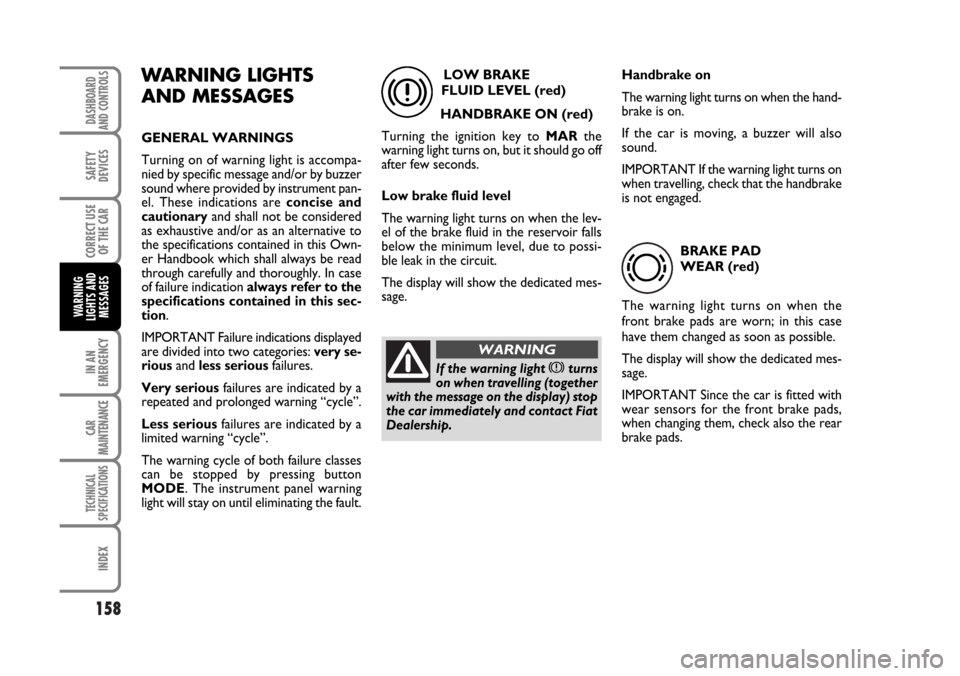
158
IN AN
EMERGENCY
CAR
MAINTENANCE
TECHNICAL
SPECIFICATIONS
INDEX
DASHBOARD
AND CONTROLS
SAFETY
DEVICES
CORRECT USE
OF THE CAR
WARNING
LIGHTS AND
MESSAGES
WARNING LIGHTS
AND MESSAGES
GENERAL WARNINGS
Turning on of warning light is accompa-
nied by specific message and/or by buzzer
sound where provided by instrument pan-
el. These indications are concise and
cautionaryand shall not be considered
as exhaustive and/or as an alternative to
the specifications contained in this Own-
er Handbook which shall always be read
through carefully and thoroughly. In case
of failure indication always refer to the
specifications contained in this sec-
tion.
IMPORTANT Failure indications displayed
are divided into two categories: very se-
riousand less seriousfailures.
Very seriousfailures are indicated by a
repeated and prolonged warning “cycle”.
Less seriousfailures are indicated by a
limited warning “cycle”.
The warning cycle of both failure classes
can be stopped by pressing button
MODE. The instrument panel warning
light will stay on until eliminating the fault.Handbrake on
The warning light turns on when the hand-
brake is on.
If the car is moving, a buzzer will also
sound.
IMPORTANT If the warning light turns on
when travelling, check that the handbrake
is not engaged. LOW BRAKE
FLUID LEVEL (red)
HANDBRAKE ON (red)
Turning the ignition key to MARthe
warning light turns on, but it should go off
after few seconds.
Low brake fluid level
The warning light turns on when the lev-
el of the brake fluid in the reservoir falls
below the minimum level, due to possi-
ble leak in the circuit.
The display will show the dedicated mes-
sage.BRAKE PAD
WEAR (red)
The warning light turns on when the
front brake pads are worn; in this case
have them changed as soon as possible.
The display will show the dedicated mes-
sage.
IMPORTANT Since the car is fitted with
wear sensors for the front brake pads,
when changing them, check also the rear
brake pads.
x
If the warning light xturns
on when travelling (together
with the message on the display) stop
the car immediately and contact Fiat
Dealership.
WARNING
d
Page 165 of 274

164
IN AN
EMERGENCY
CAR
MAINTENANCE
TECHNICAL
SPECIFICATIONS
INDEX
DASHBOARD
AND CONTROLS
SAFETY
DEVICES
CORRECT USE
OF THE CAR
WARNING
LIGHTS AND
MESSAGES
FUEL RESERVE
(amber)
Turning the ignition key to
MARthe warning light turns on,
but it should go off after few seconds.
The warning light turns on when about 8
litres fuel are left in the tank. The display
will show the dedicated message.
IMPORTANT The warning light flashes to
indicate a failure, contact Fiat Dealership
as soon as possible to have the system
checked.ENGINE CONTROL
SYSTEM FAILURE
(EOBD) (amber)
In normal conditions, turning the
ignition key to MAR, the warning light
turns on, but it should go off when the en-
gine has started. The initial turning on in-
dicates that the warning light is working
properly. If the warning light stays on or
turns on when travelling:
❒glowing steadily: means a fault in the sup-
ply/ignition system which could cause
high emissions at the exhaust, possible
lack of performance, poor handling and
high consumption levels.
The display will show the dedicated mes-
sage.
In these conditions it is possible to con-
tinue driving without however requiring
heavy effort or high speed from the en-
gine. Prolonged use of the car with the
warning light on may cause damages. Con-
tact Fiat Dealership as soon as possible.
çU
If, turning the ignition key to
MAR, the warning light Udoes not turn on or if it turns
on glowing steadily or flashing
when travelling, contact Fiat Dealer-
ship. Warning light
Uoperation can
be checked by traffic agents by prop-
er equipments, therefore comply with
laws and regulations of the country
where you are driving.
The warning light turns off if the fault dis-
appears, but it is still stored by the system.
❒flashing: indicates the possibility of dam-
age to the catalyst (see “EOBD system”
in section “Dashboard and controls”).
If the light flashes, it is necessary to release
the accelerator pedal to lower the speed
of the engine until the warning light stops
flashing; continue the journey at moder-
ate speed, trying to avoid driving condi-
tions that may cause further flashing and
contact Fiat Dealership as soon as possi-
ble.